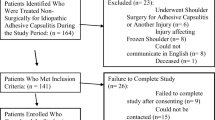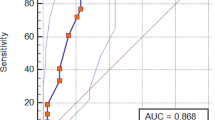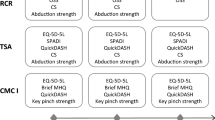Abstract
Purpose
To calculate and determine what factors are associated with achieving the Minimal Clinically Important Difference (MCID) and the Substantial Clinical Benefit (SCB) of Patient-Reported Outcomes Measurement Information System (PROMIS) Upper Extremity Computer Adaptive Testing v2.0 (UE), Pain Interference (P-Interference), and Pain Intensity (P-Intensity) in patients undergoing arthroscopic rotator cuff repair (aRCR).
Methods
The change in PROMIS scores representing the optimal cutoff for a ROC curve with an area under the curve analysis was used to calculate the anchor-based MCID and SCB. To assess the responsiveness of each PROM, effect sizes and standardized response means (SRM) were calculated. To identify factors associated with attaining the MCID and SCB, univariate and multivariate logistic regression analyses were performed.
Results
A total of 323 patients with an average age of 59.9 ± 9.5 were enrolled in this study, of which, 187/323 [57.9%] were male and 136/323 [42.1%] were female. The anchor-based MCID for PROMIS UE, P-Interference, and P-Intensity was: 9.0, 7.5, and 11.2, respectively. The respective SCB was 10.9, 9.3, and 12.7. Effect size and SRM were: PROMIS UE (1.4, 1.3), P-Interference (1.8, 1.5), and P-Intensity (2.3, 2.0). Lower preoperative P-Intensity scores (p = 0.02), dominant arm involvement (p = 0.03), and concomitant biceps tenodesis (p = 0.03) were associated with patients achieving the SCB for PROMIS UE.
Conclusion
A large responsiveness for each of the PROMIS instruments due to the majority of patients reporting great improvement after aRCR and a small standard deviation across all outcome measures was shown in our study. Lower preoperative P-Intensity scores and concomitant biceps tenodesis were associated with higher odds of achieving the SCB for PROMIS UE. The knowledge of MCID and SCB values for PROMIS instruments will allow the surgeon to determine whether the improvements in the PROMIS scores after aRCR are clinically meaningful.
Level of evidence
Level III.




Similar content being viewed by others
Data availability
The datasets generated and analyzed during the current study are available from the corresponding author on reasonable request.
References
Aflatooni JO, Meeks BD, Froehle AW, Bonner KF (2020) Biceps tenotomy versus tenodesis: patient-reported outcomes and satisfaction. J Orthop Surg Res 15(1):56
Ahmed AF, Toubasi A, Mahmoud S, Ahmed GO, AlDosari AAM, Zikria BA (2021) Long head of biceps tenotomy versus tenodesis: a systematic review and meta-analysis of randomized controlled trials. Shoulder Elbow 13(6):583–591
Anthony CA, Glass N, Hancock K, Bollier M, Hettrich CM, Wolf BR (2017) Preoperative performance of the patient-reported outcomes measurement information system in patients with rotator cuff pathology. Arthroscopy 33(10):1770-1774.e1
Ateschrang A, Eggensperger F, Ahrend MD, Schröter S, Stöckle U, Kraus TM (2018) Obesity causes poorer clinical results and higher re-tear rates in rotator cuff repair. Arch Orthop Trauma Surg 138(6):835–842
Beckerman H, Roebroeck ME, Lankhorst GJ, Becher JG, Bezemer PD, Verbeek AL (2001) Smallest real difference, a link between reproducibility and responsiveness. Qual Life Res 10(7):571–578
Berglund DD, Kurowicki J, Giveans MR, Horn B, Levy CJ (2018) Comorbidity effect on speed of recovery after arthroscopic rotator cuff repair. JSES Open Access 2(1):60–68
Bernstein ND, Houck JR, Mahmood B, Hammert CW (2019) Minimal clinically important differences for PROMIS physical function, upper extremity, and pain interference in carpal tunnel release using region- and condition-specific PROM tools. J Hand Surg 44(8):635–640
Bjorner JB, Rose M, Gandek B, Stone AA, Junghaenel DU, Ware JE Jr (2014) Method of administration of PROMIS scales did not significantly impact score level, reliability, or validity. J Clin Epidemiol 67(1):108–113
Brodke DJ, Saltzman CL, Brodke DS (2016) PROMIS for orthopaedic outcomes measurement. J Am Acad Orthop Surg 24(11):744–749
Bykerk VP (2019) Patient-reported outcomes measurement information system versus legacy instruments: are they ready for prime time? Rheum Dis Clin North Am 45(2):211–229
Christiansen DH, Frost P, Falla D, Haahr JP, Frich LH, Svendsen SW (2015) Responsiveness and minimal clinically important change: a comparison between 2 shoulder outcome measures. J Orthop Sports Phys Ther 45(8):620–625
Cheung EC, Moore LK, Flores SE, Lansdown DA, Feeley BT, Zhang AL (2019) Correlation of PROMIS with orthopaedic patient-reported outcome measures. JBJS Rev 7(8):e9
Colvin AC, Egorova N, Harrison AK, Moskowitz A, Flatow EL (2012) National trends in rotator cuff repair. J Bone Joint Surg Am 94(3):227–233
Cvetanovich GL, Gowd AK, Liu JN, Nwachukwu BU, Cabarcas BC, Cole BJ, Forsythe B, Romeo AA, Verma NN (2019) Establishing clinically significant outcome after arthroscopic rotator cuff repair. J Shoulder Elbow Surg 28(5):939–948
Day MA, Westermann RW, Bedard NA, Glass NA, Wolf BR (2019) Trends associated with open versus arthroscopic rotator cuff repair. HSS J 15(2):133–136
DeOrio JK, Cofield RH (1984) Results of a second attempt at surgical repair of a failed initial rotator-cuff repair. J Bone Joint Surg Am 66(4):563–567
Fisk F, Franovic S, Tramer JS, Gulledge C, Kuhlmann NA, Chen C, Moutzouros V, Muh S, Makhni CE (2019) PROMIS CAT forms demonstrate responsiveness in patients following arthroscopic rotator cuff repair across numerous health domains. J Shoulder Elbow Surg 28(12):2427–2432
Fries JF, Witter J, Rose M, Cella D, Khanna D, Morgan-DeWitt E (2014) Item response theory, computerized adaptive testing, and PROMIS: assessment of physical function. J Rheumatol 41(1):153–158
Gambhir N, Shankar D, Alben M, Kwon Y, Rokito A, Virk MS (2022) The effects of obesity on 1-year functional outcomes after arthroscopic rotator cuff tear repair. JSES Int 6(4):631–637
Gordon D, Pines Y, Ben-Ari E, Rokito AS, Kwon YW, Zuckerman JD, Virk MS (2021) Minimal clinically important difference, substantial clinical benefit, and patient acceptable symptom state of PROMIS upper extremity after total shoulder arthroplasty. JSES Int 5(5):894–899
Harris PA, Taylor R, Minor BL, Elliott V, Fernandez M, O’Neal L, McLeod L, Delacqua G, Delacqua F, Kirby J, Duda SN, REDCap Consortium (2019) The REDCap consortium: building an international community of software platform partners. J Biomed Inform 95:103208
Haunschild ED, Gilat R, Fu MC, Tauro T, Huddleston HP, Yanke AB, Forsythe B, Verma NN, Cole BJ (2020) Establishing the minimal clinically important difference, patient acceptable symptomatic state, and substantial clinical benefit of the promis upper extremity questionnaire after rotator cuff repair. Am J Sports Med 48(14):3439–3446
Horn ME, Reinke EK, Yan X, Luo S, Bolognesi M, Reeve BB, George SZ, Comprehensive Outcomes in Orthopaedics and Rehabilitation Data System (COORDS) group (2021) Use of patient-reported outcomes measurement information system (PROMIS) measures to characterise health status for patients seeking care from an orthopaedic provider: a retrospective cohort study. BMJ Open 11(9):e047156
Hung M, Saltzman CL, Kendall R, Bounsanga J, Voss MW, Lawrence B, Spiker R, Brodke D (2018) What are the MCIDs for PROMIS, NDI, and ODI instruments among patients with spinal conditions? Clin Orthop Relat Res 476(10):2027–2036
Jaeschke R, Singer J, Guyatt GH (1989) Measurement of health status. Ascertaining the minimal clinically important difference. Control Clin Trials 10(4):407–415
Karhade AV, Bernstein DN, Desai V, Bedair HS, O’Donnell EA, Tanaka MJ, Bono CM, Harris MB, Schwab JH, Tobert DG (2022) What is the clinical benefit of common orthopaedic procedures as assessed by the PROMIS versus other validated outcomes tools? Clin Orthop Relat Res 480(9):1672–1681
Kelly MA, Mc Donald CK, Boland A, Groarke PJ, Kaar K (2017) The effect of hand dominance on functional outcome following single row rotator cuff repair. Open J Orthop 11:562–566
Kim MD, Kim HT, Kholinne E, Park JH, Shin MJ, Kim H, Park D, Jeon IH, Koh KH (2020) Minimal clinically important difference, substantial clinical benefit, and patient acceptable symptomatic state after arthroscopic rotator cuff repair. Am J Sports Med 48(11):2650–2659
Kolade O, Ghosh N, Luthringer TA, Rosenthal Y, Kwon YW, Rokito AS, Zuckerman JD, Virk MS (2021) Correlation of patient reported outcome measurement information system (PROMIS) with American shoulder and elbow surgeon (ASES), and constant (CS) scores in idiopathic adhesive capsulitis. J Shoulder Elbow Surg 30(3):554–560
Kurowicki J, Berglund DD, Momoh E, Disla S, Horn B, Giveans MR, Levy JC (2017) Speed of recovery after arthroscopic rotator cuff repair. J Shoulder Elbow Surg 26(7):1271–1277
Longo UG, Berton A, De Salvatore S, Piergentili I, Casciani E, Faldetta A, De Marinis MG, Denaro V (2021) Minimal clinically important difference and patient acceptable symptom state for the pittsburgh sleep quality index in patients who underwent rotator cuff tear repair. Int J Environ Res Public Health 18(16):8666
Louwerens J, van den Bekerom M, van Royen BJ, Eygendaal D, van Noort A, Sierevelt IN (2020) Quantifying the minimal and substantial clinical benefit of the Constant-Murley score and the disabilities of the arm, shoulder and hand score in patients with calcific tendinitis of the rotator cuff. JSES Int 4(3):606–611
MacDonald P, Verhulst F, McRae S, Old J, Stranges G, Dubberley J, Mascarenhas R, Koenig J, Leiter J, Nassar M, Lapner P (2020) Biceps tenodesis versus tenotomy in the treatment of lesions of the long head of the biceps tendon in patients undergoing arthroscopic shoulder surgery: a prospective double-blinded randomized controlled Trial. Am J Sports Med 48(6):1439–1449
Malavolta EA, Yamamoto GJ, Bussius DT, Assunção JH, Andrade-Silva FB, Gracitelli M, Ferreira Neto AA (2021) Establishing minimal clinically important difference for the UCLA and ASES scores after rotator cuff repair. Orthop Traumatol Sur 108(2):102894
Mollon B, Mahure SA, Roche CP, Zuckerman JD (2016) Impact of glenosphere size on clinical outcomes after reverse total shoulder arthroplasty: an analysis of 297 shoulders. J Shoulder Elbow Surg 25(5):763–771
Nicholson AD, Kassam HF, Pan SD, Berman JE, Blaine TA, Kovacevic D (2019) Performance of PROMIS global-10 compared with legacy instruments for rotator cuff disease. Am J Sports Med 47(1):181–188
Norman GR, Wyrwich KW, Patrick DL (2007) The mathematical relationship among different forms of responsiveness coefficients. Qual Life Res 16(5):815–822
Ogura T, Ackermann J, Barbieri Mestriner A, Merkely G, Gomoll AH (2020) Minimal clinically important differences and substantial clinical benefit in patient-reported outcome measures after autologous chondrocyte implantation. Cartilage 11(4):412–422
O’Hara NN, Richards JT, Overmann A, Slobogean GP, Klazinga NS (2020) Is PROMIS the new standard for patient-reported outcomes measures in orthopaedic trauma research? Injury 51(Suppl 2):S43–S50
Patterson BM, Orvets ND, Aleem AW, Keener JD, Calfee RP, Nixon DC, Chamberlain AM (2018) Correlation of patient-reported outcomes measurement information system (PROMIS) scores with legacy patient-reported outcome scores in patients undergoing rotator cuff repair. J Shoulder Elbow Surg 27(6S):S17–S23
Pines Y, Gordon D, Alben M, Kwon YW, Zuckerman JD, Virk MS (2022) Performance and responsiveness to change of PROMIS UE in patients undergoing total shoulder arthroplasty. J Orthop Res. https://doi.org/10.1002/jor.25263
Rai SK, Yazdany J, Fortin PR, Aviña-Zubieta JA (2015) Approaches for estimating minimal clinically important differences in systemic lupus erythematosus. Arthritis Res Ther 17(1):143
Rose M, Bjorner JB, Becker J, Fries JF, Ware JE (2008) Evaluation of a preliminary physical function item bank supported the expected advantages of the patient-reported outcomes measurement information system (PROMIS). J Clin Epidemiol 61(1):17–33
Schwarz I, Smith JH, Houck DA, Frank RM, Bravman JT, McCarty EC (2020) Use of the patient-reported outcomes measurement information system (PROMIS) for operative shoulder outcomes. Orthop J Sports Med 8(6):2325967120924345
Sedaghat AR (2019) Understanding the minimal clinically important difference (MCID) of patient-reported outcome measures. Otolaryngol Head Neck Surg 161(4):551–560
Sullivan GM, Feinn R (2012) Using effect size-or why the p value is not enough. J Grad Med Educ 4(3):279–282
Vadhera AS, Beletsky A, Singh H, Chahla J, Cole BJ, Verma NN (2021) Preoperative psychometric properties of patient-reported outcomes measurement information system upper extremity, pain interference, and depression in bankart repair and rotator cuff repair. J Shoulder Elbow Surg 30(10):2225–2230
Warrender WJ, Brown OL, Abboud JA (2011) Outcomes of arthroscopic rotator cuff repairs in obese patients. J Shoulder Elbow Surg 20(6):961–967
Wells G, Beaton D, Shea B, Boers M, Simon L, Strand V, Brooks P, Tugwell P (2001) Minimal clinically important differences: review of methods. J Rheumatol 28(2):406–412
Wong LH, Meeker JE (2022) The promise of computer adaptive testing in collection of orthopaedic outcomes: an evaluation of PROMIS utilization. J Patient Rep Outcomes 6(1):2
Yanik EL, Chamberlain AM, Keener JD (2021) Trends in rotator cuff repair rates and comorbidity burden among commercially insured patients younger than the age of 65 years, United States 2007–2016. JSES Rev Rep Tech 1(4):309–316
Xu S, Chen JY, Lie H, Hao Y, Lie D (2019) Minimal clinically important difference of Oxford, constant, and UCLA shoulder score for arthroscopic rotator cuff repair. J Orthop 19:21–27
Zhou P, Liu J, Deng X, Li Z (2021) Biceps tenotomy versus tenodesis for lesions of the long head of the biceps tendon: a systematic review and meta-analysis of randomized controlled trials. Medicine (Baltimore) 100(3):e23993
Funding
This study was funded by New York University Langone Health, no external funding was received. The authors of this paper certify that they have no affiliations with or involvement in any organization or entity with any financial or non-financial interests pertinent to the subject matter discussed in this manuscript.
Author information
Authors and Affiliations
Corresponding author
Ethics declarations
Ethical approval
This study was approved by the NYU Langone Health Institutional Review Board (s20-00287).
Conflict of interest
Joseph D. Zuckerman, MD: Apos Therapy, Inc. (Stock); Hip Innovation Technology (Stock); Musculoskeletal Transplant Foundation (Board Member); SLACK Inc. (Publishing Royalties); Thieme Inc. (Publishing Royalties); Wolters Kluwer Health (Publishing Royalties); Exactech (Design Surgeon, Royalties). Mandeep S. Virk, MD: Exactech (Paid Consultant); Acumed Inc. (Paid Consultant). The other authors of this paper certify that they have NO affiliations with or involvement in any organization or entity with any financial or non-financial interests pertinent to the subject matter discussed in this manuscript.
Additional information
Publisher's Note
Springer Nature remains neutral with regard to jurisdictional claims in published maps and institutional affiliations.
Rights and permissions
Springer Nature or its licensor (e.g. a society or other partner) holds exclusive rights to this article under a publishing agreement with the author(s) or other rightsholder(s); author self-archiving of the accepted manuscript version of this article is solely governed by the terms of such publishing agreement and applicable law.
About this article
Cite this article
Alben, M.G., Gordon, D., Gambhir, N. et al. Minimal clinically important difference (MCID) and substantial clinical benefit (SCB) of upper extremity PROMIS scores following arthroscopic rotator cuff repairs. Knee Surg Sports Traumatol Arthrosc 31, 2602–2614 (2023). https://doi.org/10.1007/s00167-022-07279-7
Received:
Accepted:
Published:
Issue Date:
DOI: https://doi.org/10.1007/s00167-022-07279-7




